Convection-Permitting Ability in Simulating an Extratropical Cyclone Case over Southeastern South America
Abstract
1. Introduction
2. Materials and Methods
2.1. Study Area and Data
2.2. WRF Model and Experimental Design
2.3. Analyses
3. Results
3.1. Synoptic Features
3.2. Mesoscale Features
3.3. Local Weather Associated with the Cyclone
4. Discussion and Conclusions
Supplementary Materials
Author Contributions
Funding
Institutional Review Board Statement
Informed Consent Statement
Data Availability Statement
Acknowledgments
Conflicts of Interest
References
- Innocentini, V.; Neto, E.D.S.C. A case study of the 9 August 1988 South Atlantic storm: Numerical simulations of the wave activity. Weather Forecast. 1996, 11, 78–88. [Google Scholar] [CrossRef]
- da Rocha, R.P.; Sugahara, S.; da Silveira, R.B. Sea waves generated by extratropical cyclones in the South Atlantic Ocean: Hindcast and validation against altimeter data. Weather Forecast. 2004, 19, 398–410. [Google Scholar] [CrossRef]
- Brasiliense, C.S.; Dereczynski, C.P.; Satyamurty, P.; Chou, S.C.; da Silva Santos, V.R.; Calado, R.N. Synoptic analysis of an intense rainfall event in Paraíba do Sul river basin in southeast Brazil. Meteorol. Appl. 2018, 25, 66–77. [Google Scholar] [CrossRef]
- Reboita, M.S.; da Rocha, R.P.; Oliveira, D.M.d. Key Features and Adverse Weather of the Named Subtropical Cyclones over the Southwestern South Atlantic Ocean. Atmosphere 2019, 10, 6. [Google Scholar] [CrossRef]
- Cardoso, A.A.; da Rocha, R.P.; Crespo, N.M. Synoptic Climatology of Subtropical Cyclone Impacts on Near-Surface Winds Over the South Atlantic Basin. Earth Space Sci. 2022, 9, e2022EA002482. [Google Scholar] [CrossRef]
- Gramcianinov, C.B.; de Camargo, R.; Campos, R.M.; Guedes Soares, C.; da Silva Dias, P.L. Impact of extratropical cyclone intensity and speed on the extreme wave trends in the Atlantic Ocean. Clim. Dyn. 2023, 60, 1447–1466. [Google Scholar] [CrossRef]
- Bartolomei, F.; Reboita, M.S.; da Rocha, R.P. Ciclones extratropicais causadores de eventos extremos no sul do Brasil no inverno de 2023. Terrae Didat. 2024, 20, e024003. [Google Scholar] [CrossRef]
- Zhou, L.; Harris, L.; Chen, J.H.; Gao, K.; Cheng, K.Y.; Tong, M.; Kaltenbaugh, A.; Morin, M.; Mouallem, J.; Chilutti, L.; et al. Bridging the gap between global weather prediction and global storm-resolving simulation: Introducing the GFDL 6.5-km SHiELD. J. Adv. Model. Earth Syst. 2024, 16, e2024MS004430. [Google Scholar] [CrossRef]
- Prein, A.F.; Gobiet, A.; Suklitsch, M.; Truhetz, H.; Awan, N.K.; Keuler, K.; Georgievski, G. Added value of convection permitting seasonal simulations. Clim. Dyn. 2013, 41, 2655–2677. [Google Scholar] [CrossRef]
- Prein, A.F.; Langhans, W.; Fosser, G.; Ferrone, A.; Ban, N.; Goergen, K.; Keller, M.; Tölle, M.; Gutjahr, O.; Feser, F.; et al. A review on regional convection-permitting climate modeling: Demonstrations, prospects, and challenges. Rev. Geophys. 2015, 53, 323–361. [Google Scholar] [CrossRef]
- Lucas-Picher, P.; Argüeso, D.; Brisson, E.; Tramblay, Y.; Berg, P.; Lemonsu, A.; Kotlarski, S.; Caillaud, C. Convection-permitting modeling with regional climate models: Latest developments and next steps. Wiley Interdiscip. Rev. Clim. Change 2021, 12, e731. [Google Scholar] [CrossRef]
- Prein, A.F.; Liu, C.; Ikeda, K.; Bullock, R.; Rasmussen, R.M.; Holland, G.J.; Clark, M. Simulating North American mesoscale convective systems with a convection-permitting climate model. Clim. Dyn. 2020, 55, 95–110. [Google Scholar] [CrossRef]
- Leutwyler, D.; Lüthi, D.; Ban, N.; Fuhrer, O.; Schär, C. Evaluation of the convection-resolving climate modeling approach on continental scales. J. Geophys. Res. Atmos. 2017, 122, 5237–5258. [Google Scholar] [CrossRef]
- Dominguez, F.; Rasmussen, R.; Liu, C.; Ikeda, K.; Prein, A.; Varble, A.; Arias, P.A.; Bacmeister, J.; Bettolli, M.L.; Callaghan, P.; et al. Advancing South American Water and Climate Science through Multidecadal Convection-Permitting Modeling. Bull. Am. Meteorol. Soc. 2024, 105, E32–E44. [Google Scholar] [CrossRef]
- Torma, C.Z.; Giorgi, F. Convection Permitting Regional Climate Modelling Over the Carpathian Region. Earth Syst. Environ. 2024, 1–16. [Google Scholar] [CrossRef]
- Rosales, A.G.; Junquas, C.; da Rocha, R.P.; Condom, T.; Espinoza, J.C. Valley–mountain circulation associated with the diurnal cycle of precipitation in the tropical Andes (Santa River basin, Peru). Atmosphere 2022, 13, 344. [Google Scholar] [CrossRef]
- Expósito, F.J.; González, A.; Pérez, J.C.; Díaz, J.P.; Taima, D. High-resolution future projections of temperature and precipitation in the Canary Islands. J. Clim. 2015, 28, 7846–7856. [Google Scholar] [CrossRef]
- Coppola, E.; Stocchi, P.; Pichelli, E.; Torres-Alavez, J.A.; Glazer, R.; Giuliani, G.; Sante, F.D.; Nogherotto, R.; Giorgi, F. Non-Hydrostatic RegCM4 (RegCM4-NH): Model description and case studies over multiple domains. Geosci. Model Dev. 2021, 14, 7705–7723. [Google Scholar] [CrossRef]
- Meredith, E.P.; Ulbrich, U.; Rust, H.W. Subhourly rainfall in a convection-permitting model. Environ. Res. Lett. 2020, 15, 034031. [Google Scholar] [CrossRef]
- Hwang, Y.; Ma, X.; Agyeman, R.Y.; Li, Y. Climatological features of future MCSs over the Canadian Prairies using convection-permitting climate models. Atmos. Res. 2023, 293, 106922. [Google Scholar] [CrossRef]
- Akinsanola, A.A.; Jung, C.; Wang, J.; Kotamarthi, V.R. Evaluation of precipitation across the contiguous United States, Alaska, and Puerto Rico in multi-decadal convection-permitting simulations. Sci. Rep. 2024, 14, 1238. [Google Scholar] [CrossRef]
- Song, J.; Song, F.; Feng, Z.; Leung, L.R.; Li, C.; Wu, L. Realistic precipitation diurnal cycle in global convection-permitting models by resolving mesoscale convective systems. Geophys. Res. Lett. 2024, 51, e2024GL109945. [Google Scholar] [CrossRef]
- Short, E.; Lane, T.P. Objectively Assessing Characteristics of Mesoscale Convective Organization in an Operational Convection-Permitting Model. Mon. Weather Rev. 2023, 151, 2819–2841. [Google Scholar] [CrossRef]
- Cioni, G.; Cerrai, D.; Klocke, D. Investigating the predictability of a Mediterranean tropical-like cyclone using a storm-resolving model. Q. J. R. Meteorol. Soc. 2018, 144, 1598–1610. [Google Scholar] [CrossRef]
- Bouin, M.N.; Lebeaupin Brossier, C. Surface processes in the 7 November 2014 medicane from air–sea coupled high-resolution numerical modelling. Atmos. Chem. Phys. 2019, 20, 6861–6881. [Google Scholar] [CrossRef]
- Defesa Civil. Ciclone No RS—Medidas Emergenciais; Governo do Estado do Rio Grande do Sul; 2023. Available online: https://estado.rs.gov.br/upload/arquivos/2023-06-28-govrs-ciclone-medidas.pdf (accessed on 27 November 2024).
- Hersbach, H.; Bell, B.; Berrisford, P.; Hirahara, S.; Horányi, A.; Muñoz-Sabater, J.; Nicolas, J.; Peubey, C.; Radu, R.; Schepers, D.; et al. The ERA5 global reanalysis. Q. J. R. Meteorol. Soc. 2020, 146, 1999–2049. [Google Scholar] [CrossRef]
- Beck, H.E.; Van Dijk, A.I.J.M.; Larraondo, P.R.; McVicar, T.R.; Pan, M.; Dutra, E.; Miralles, D.G. MSWX: Global 3-hourly 0.1° bias-corrected meteorological data including near real-time updates and forecast ensembles. Bull. Am. Meteorol. Soc. 2022, 103, E710–E732. [Google Scholar] [CrossRef]
- Marshall, J.S.; Palmer, W.M.K. The distribution of raindrops with size. J. Atmos. Sci. 1948, 5, 165–166. [Google Scholar] [CrossRef]
- Lopez, A.S.V.; Ribeiro, B.Z.; Morales, C.A.R.; dos Santos, D.M.B.; Enoré, D.P.; Vendrasco, E.P.; de Freitas, E.D.; Nascimento, E.L.; Schild, G.; Saraiva, I.; et al. Diretrizes para a Implementação do Nowcasting No Brasil; Instituto Nacional de Pesquisas Espaciais: São José, Brazil, 2024; 227p. [Google Scholar]
- Skamarock, W.C.; Klemp, J.B.; Dudhia, J.; Gill, D.O.; Barker, D.M.; Duda, M.G.; Huang, X.; Wang, W.; Powers, J.G. A Description of the Advanced Research WRF Version 3; National Center for Atmospheric Research: Boulder, CO, USA, 2008; 126p. [Google Scholar]
- Conrado, E.T.C. Estudo das Parametrizações de Microfísica de Nuvens na Simulação de Ciclones Subtropicais. Undergraduate Thesis, DCA-IAG-USP, Rua do Matão, São Paulo, Brazil, 2021. [Google Scholar]
- Reboita, M.S.; Gozzo, L.F.; Crespo, N.M.; Custodio, M.D.S.; Lucyrio, V.; de Jesus, E.M.; da Rocha, R.P. From a Shapiro–Keyser extratropical cyclone to the subtropical cyclone Raoni: An unusual winter synoptic situation over the South Atlantic Ocean. Q. J. R. Meteorol. Soc. 2022, 148, 2991–3009. [Google Scholar] [CrossRef]
- Iacono, M.J.; Delamere, J.S.; Mlawer, E.J.; Shephard, M.W.; Clough, S.A.; Collins, W.D. Radiative forcing by long-lived greenhouse gases: Calculations with the AER radiative transfer models. J. Geophys. Res. Atmos. 2008, 113, D13103. [Google Scholar] [CrossRef]
- Hong, S.Y.; Noh, Y.; Dudhia, J. A new vertical diffusion package with an explicit treatment of entrainment processes. Mon. Weather Rev. 2006, 134, 2318–2341. [Google Scholar] [CrossRef]
- Janjic, Z.I. The surface layer in the NCEP eta model. In Proceedings of the 11th Conference on Numerical Weather Prediction, Norfolk, VA, USA, 19–23 August 1996; American Meteorology Society: Boston, MA, USA, 1996; pp. 354–355. [Google Scholar]
- Bougeault, P.; Lacarrere, P. Parameterization of orography-induced turbulence in a mesobeta-scale model. Mon. Weather Rev. 1989, 117, 1872–1890. [Google Scholar] [CrossRef]
- Maria, E.; Budiman, E.; Taruk, M. Measure distance locating nearest public facilities using Haversine and Euclidean Methods. J. Phys. Conf. Ser. 2020, 1450, 012080. [Google Scholar] [CrossRef]
- Akoglu, H. User’s guide to correlation coefficients. Turk. J. Emerg. Med. 2018, 18, 91–93. [Google Scholar] [CrossRef]
- Di, Y.; Li, R. Correlation analysis of AQI characteristics and meteorological conditions in heating season. In IOP Conference Series: Earth and Environmental Science; IOP Publishing: Bristol, UK, 2019; p. 022067. [Google Scholar]
- Zhang, H.; Pu, Z.; Zhang, X. Examination of errors in near-surface temperature and wind from WRF numerical simulations in regions of complex terrain. Weather Forecast. 2013, 28, 893–914. [Google Scholar] [CrossRef]
- Xue, W.; Yu, H.; Tang, S.; Huang, W. Relationships between Terrain Features and Forecasting Errors of Surface Wind Speeds in a Mesoscale Numerical Weather Prediction Model. Adv. Atmos. Sci. 2024, 41, 1161–1170. [Google Scholar] [CrossRef]
- Vaisala. Wind Sens. 2025. Available online: https://www.vaisala.com/en/products/weather-environmental-sensors/wind (accessed on 20 April 2025).
- Vaisala. Precipitation Sensors. 2025. Available online: https://www.vaisala.com/en/products/weather-environmental-sensors/precipitation (accessed on 20 April 2025).
- Willmott, C.J. On the validation of models. Phys. Geogr. 1981, 2, 184–194. [Google Scholar] [CrossRef]
- Cao, H.X.; Hanan, J.S.; Yan, L.; Liu, Y.X.; Yue, Y.B.; Zhu, D.W.; Lu, J.F.; Sun, J.Y.; Shi, C.L.; Ge, D.K.; et al. Comparison of crop model validation methods. J. Integr. Agric. 2012, 11, 1274–1285. [Google Scholar] [CrossRef]
- Bluestein, H.B. Synoptic-Dynamic Meteorology in Midlatitudes Vol. 2.: Observations and Theory of Weather Systems; Oxford University Press: New York, NY, USA, 1992. [Google Scholar]
- Povey, A.C.; Grainger, R.G. Known and unknown unknowns: Uncertainty estimation in satellite remote sensing. Atmos. Meas. Tech. 2015, 8, 4699–4718. [Google Scholar] [CrossRef]
- Khojand, K.; Shaghaghian, M.R.; Ghadampour, Z.; Sabzevari, T. Validity, reliability and certainty of PERSIANN and TRMM satellite-derived daily precipitation data in arid and semiarid climates. Acta Geophys. 2022, 70, 1745–1767. [Google Scholar] [CrossRef]
- Wernli, H.; Gray, S.L. The importance of diabatic processes for the dynamics of synoptic-scale extratropical weather systems—A review. Weather Clim. Dyn. 2024, 5, 1299–1408. [Google Scholar] [CrossRef]
- Bechini, R.; Chandrasekar, V. An enhanced optical flow technique for radar nowcasting of precipitation and winds. J. Atmos. Ocean. Technol. 2017, 34, 2637–2658. [Google Scholar] [CrossRef]
- Keyser, D. Atmospheric fronts: An observational perspective. In Mesoscale Meteorology and Forecasting; Ray, P.S., Ed.; American Meteorological Society: Boston, MA, USA, 1986. [Google Scholar] [CrossRef]
- Wang, S.; Fu, G.; Pang, H. Structure analyses of the explosive extratropical cyclone: A case study over the Northwestern Pacific in March 2007. J. Ocean Univ. China 2017, 16, 933–944. [Google Scholar] [CrossRef][Green Version]
- Browning, K.A. Conceptual models of precipitation systems. Weather Forecast. 1986, 1, 23–41. [Google Scholar] [CrossRef]
- Saarikivi, P.; Puhakka, T. The structure and evolution of a wintertime occluded front. Tellus A 1990, 42, 122–139. Available online: https://onlinelibrary.wiley.com (accessed on 29 May 2025). [CrossRef][Green Version]
- Stewart, R.E. Extratropical Cyclones: Their Mesoscale Structure, Precipitation and Role in the Transport of Water. In Radiation and Water in the Climate System; Raschke, E., Ed.; Nato ASI Series; Springer: Berlin/Heidelberg, Germany, 1986; Volume 45. [Google Scholar] [CrossRef]
- Szeto, K.K.; Stewart, R.E. Effects of melting on frontogenesis. J. Atmos. Sci. 1997, 54, 689–702. [Google Scholar] [CrossRef]
- Cotton, W.R.; Bryan, G.; van den Heever, S.C. The mesoscale structure of extratropical cyclones and middle and high clouds. In Storm and Cloud Dynamics; Cotton, W.R., Bryan, G., van den Heever, S.C., Eds.; Academic Press Inc.: San Diego, CA, USA, 1992; pp. 714–787. [Google Scholar]
- Clark, M.R. Mesoscale cyclonic storms associated with tornadoes and localised wind damage in frontal rainbands. Weather 2024, 79, 108–123. [Google Scholar] [CrossRef]
- Market, P.S.; Moore, J.T. Mesoscale evolution of a continental occluded cyclone. Mon. Weather. Rev. 1998, 126, 1793–1811. [Google Scholar] [CrossRef]
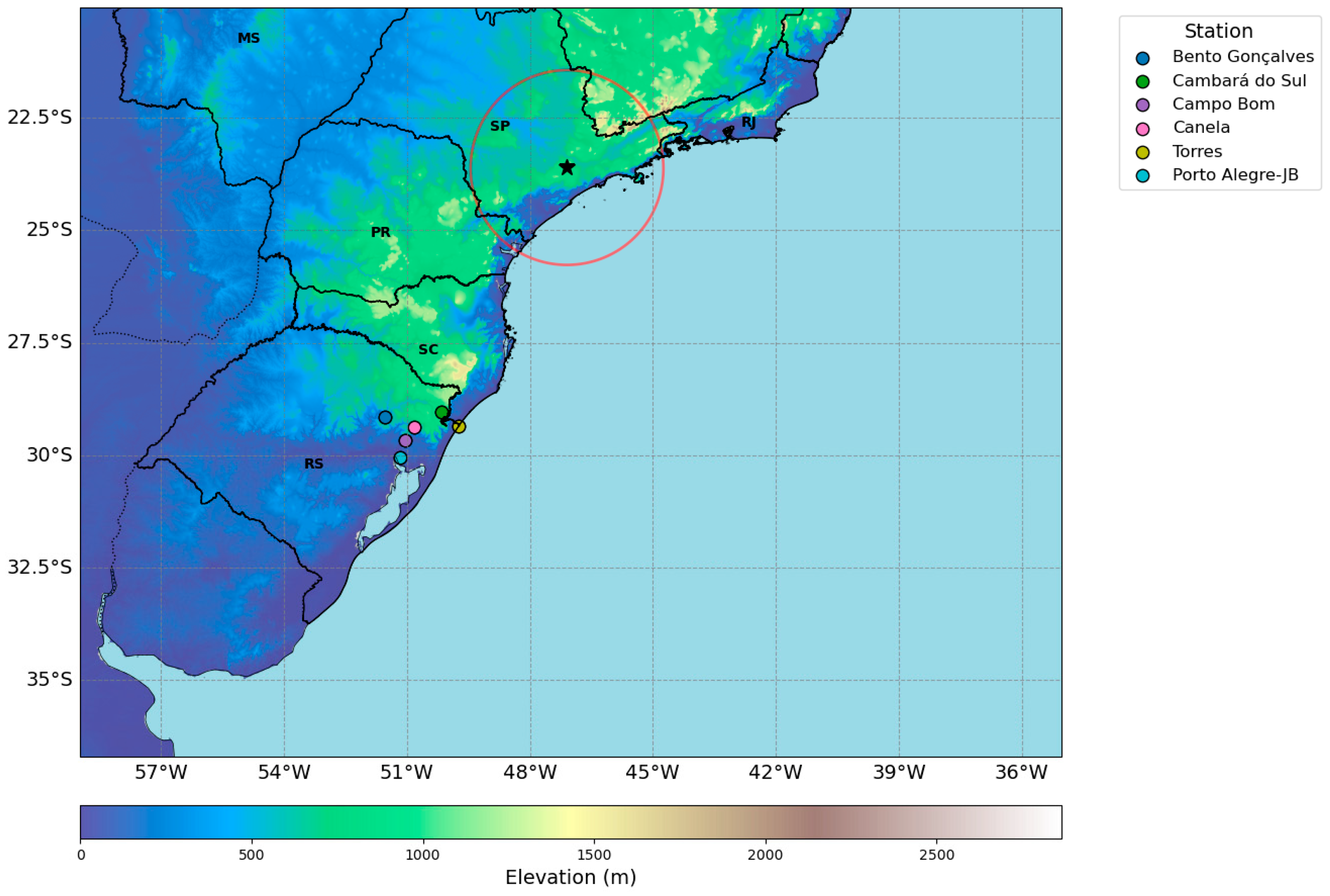

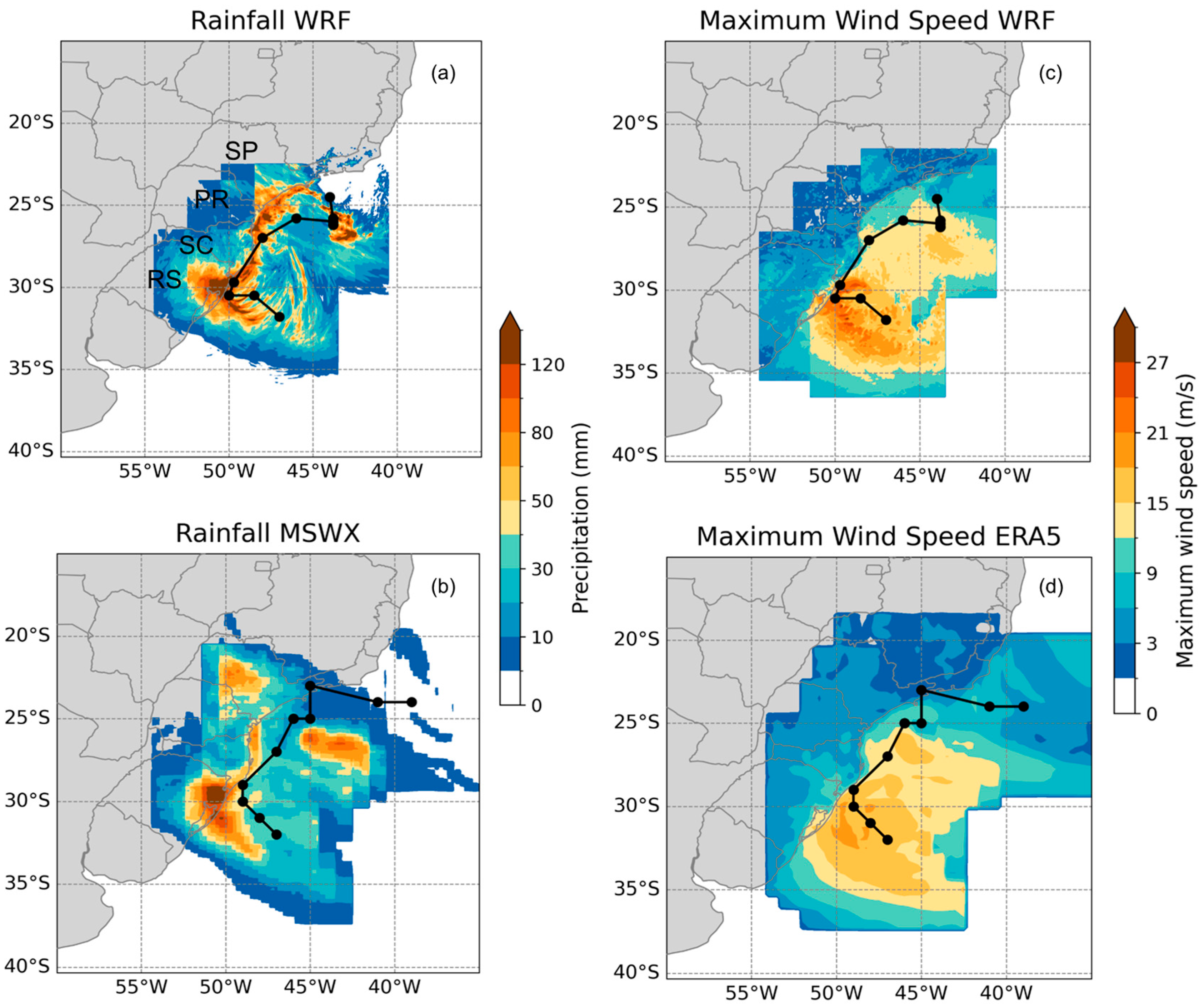
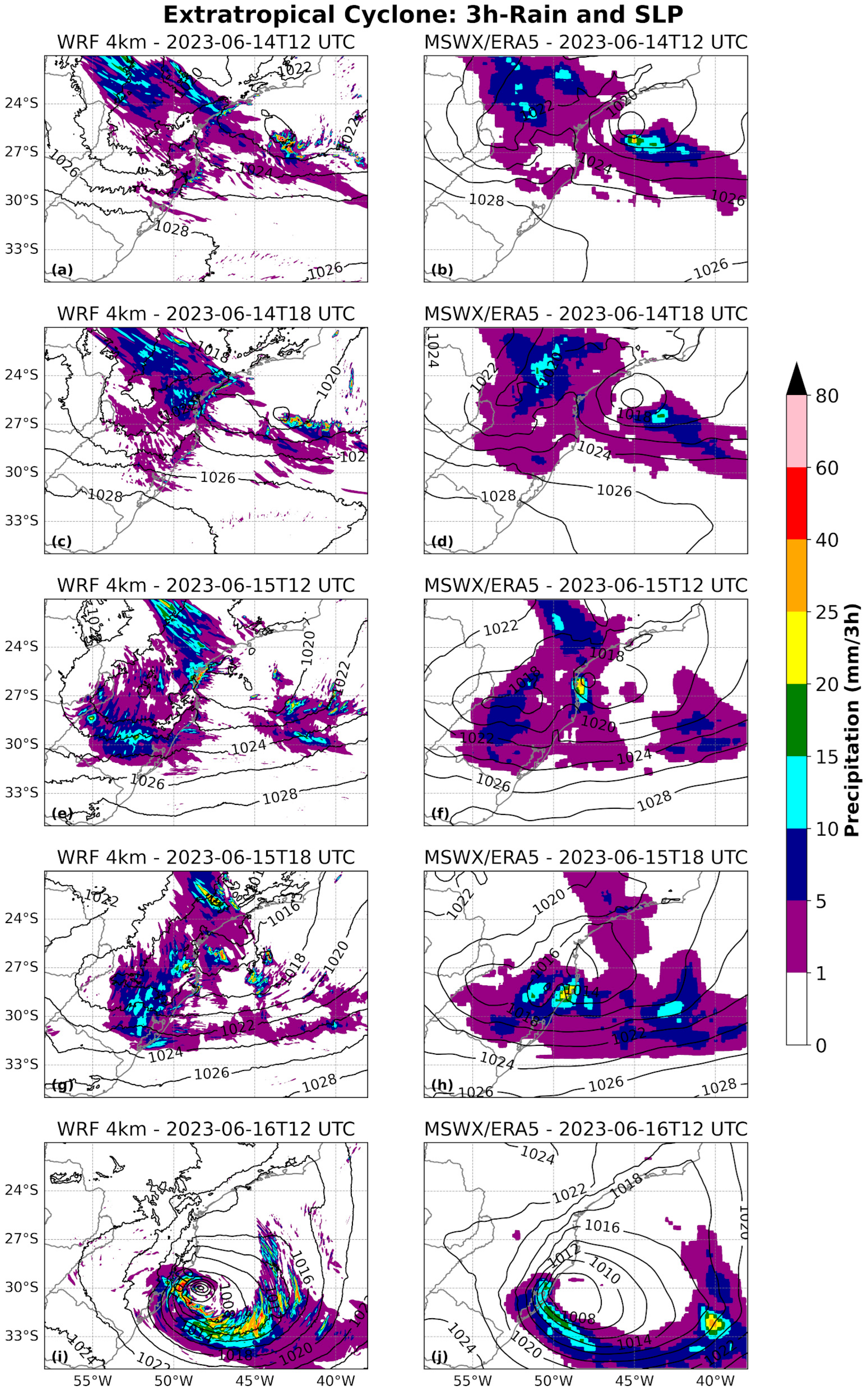
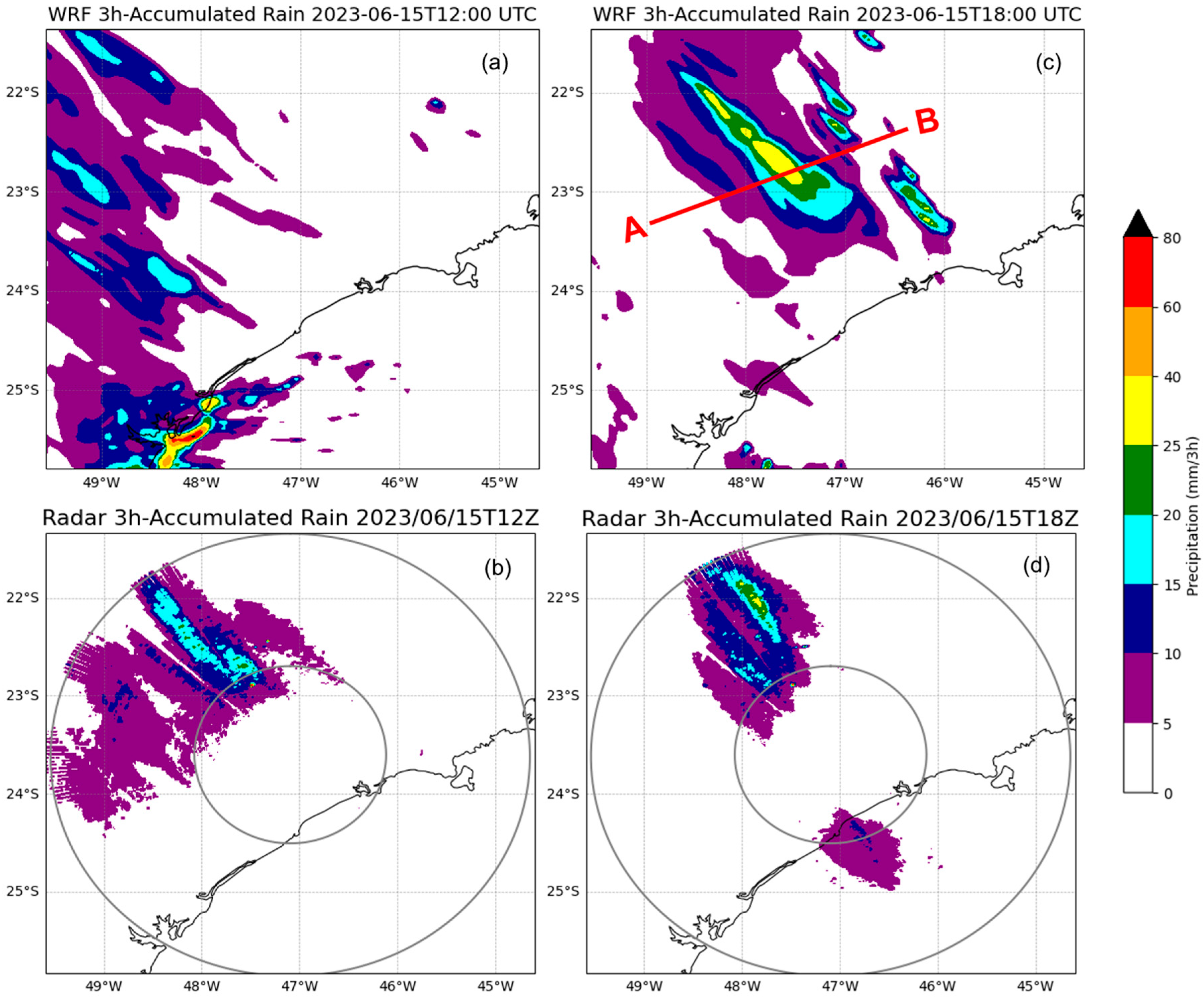
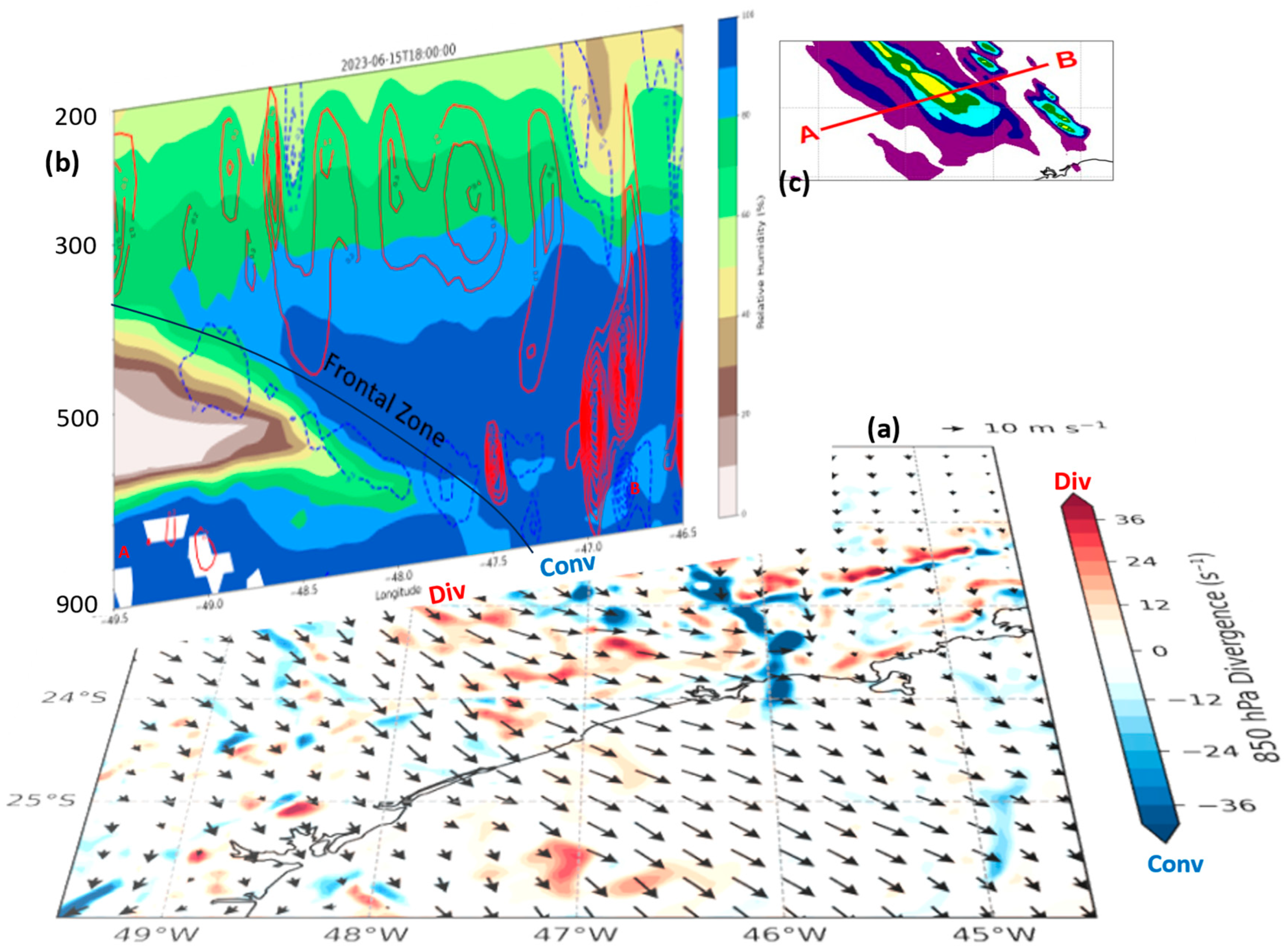
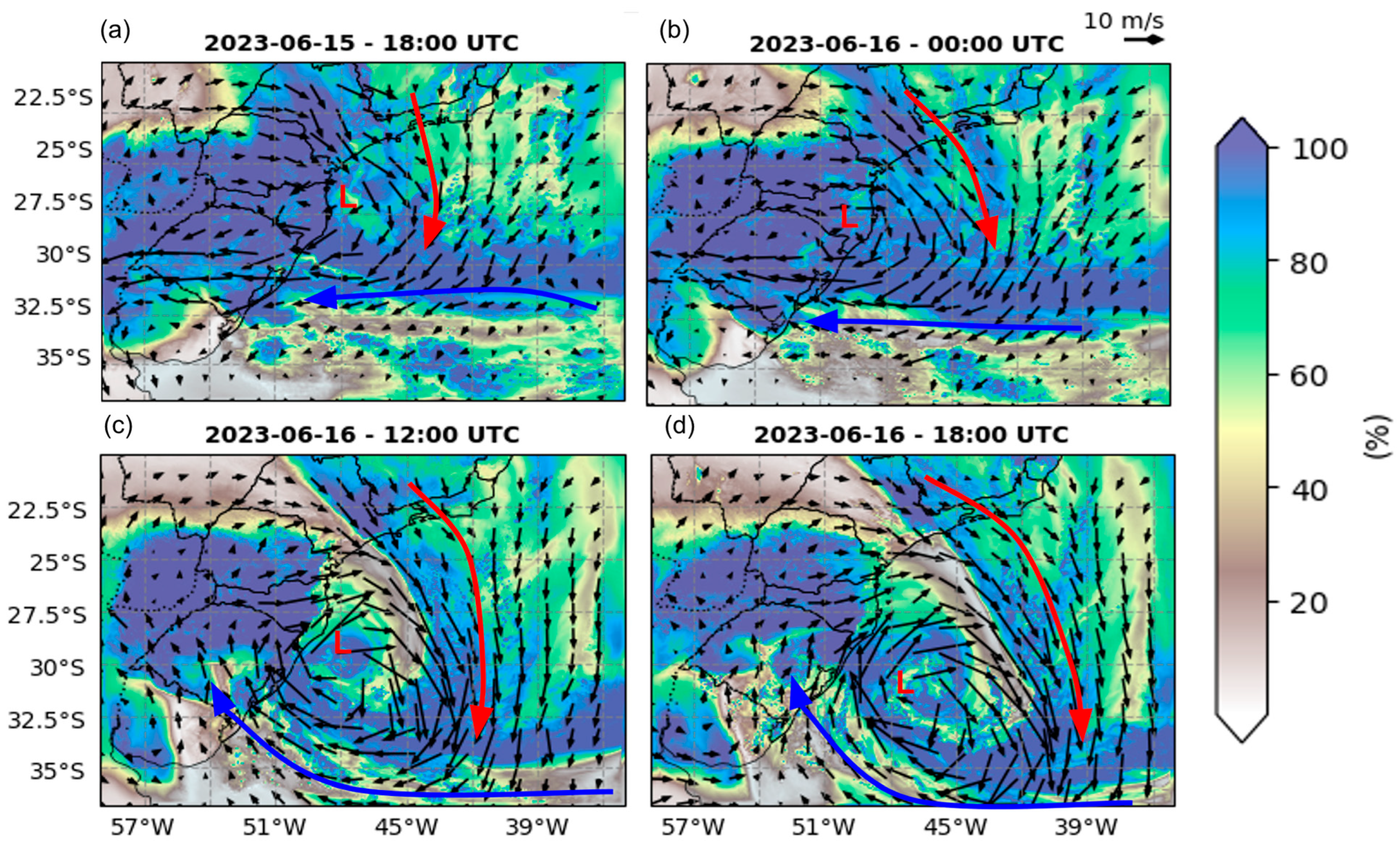
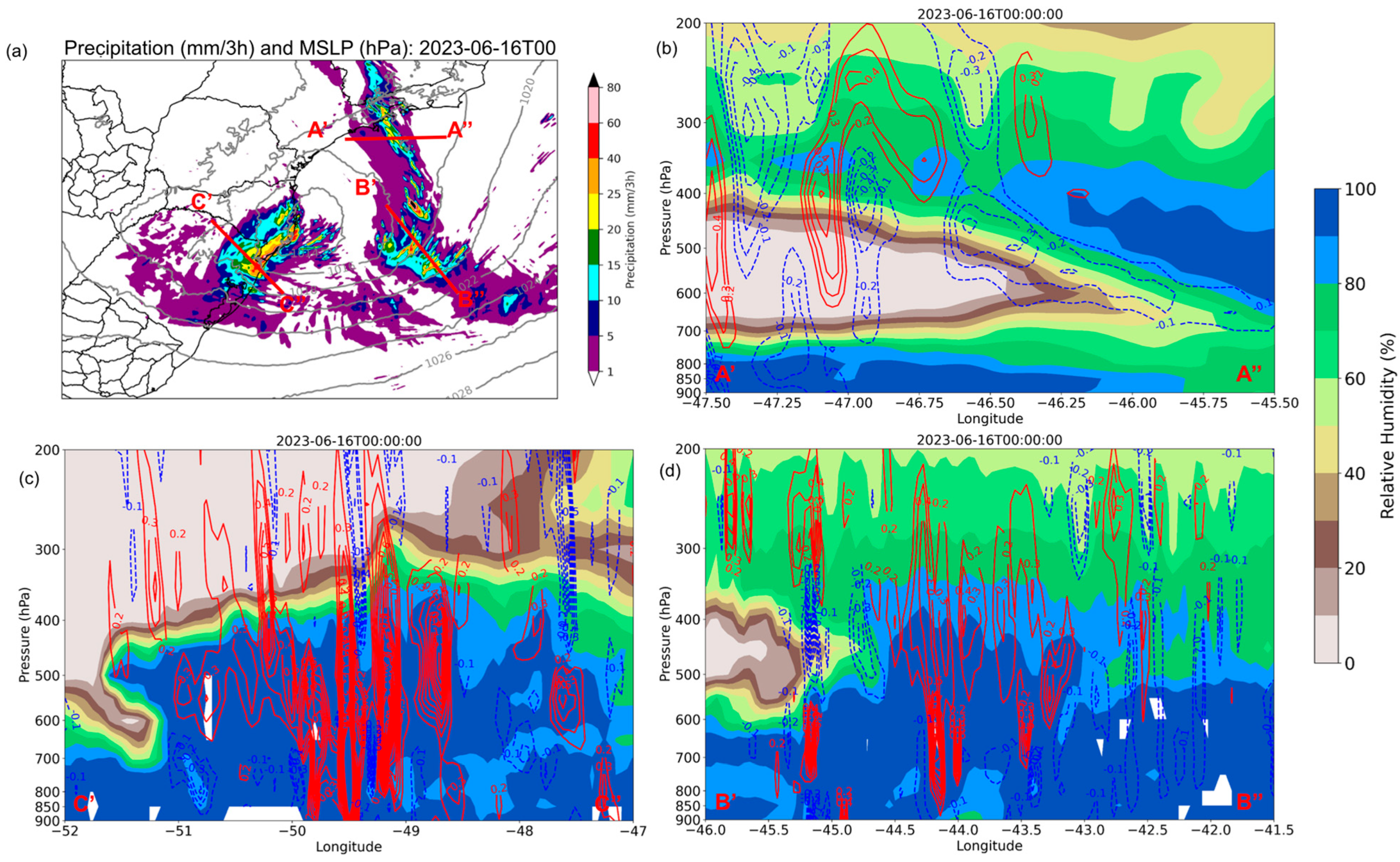
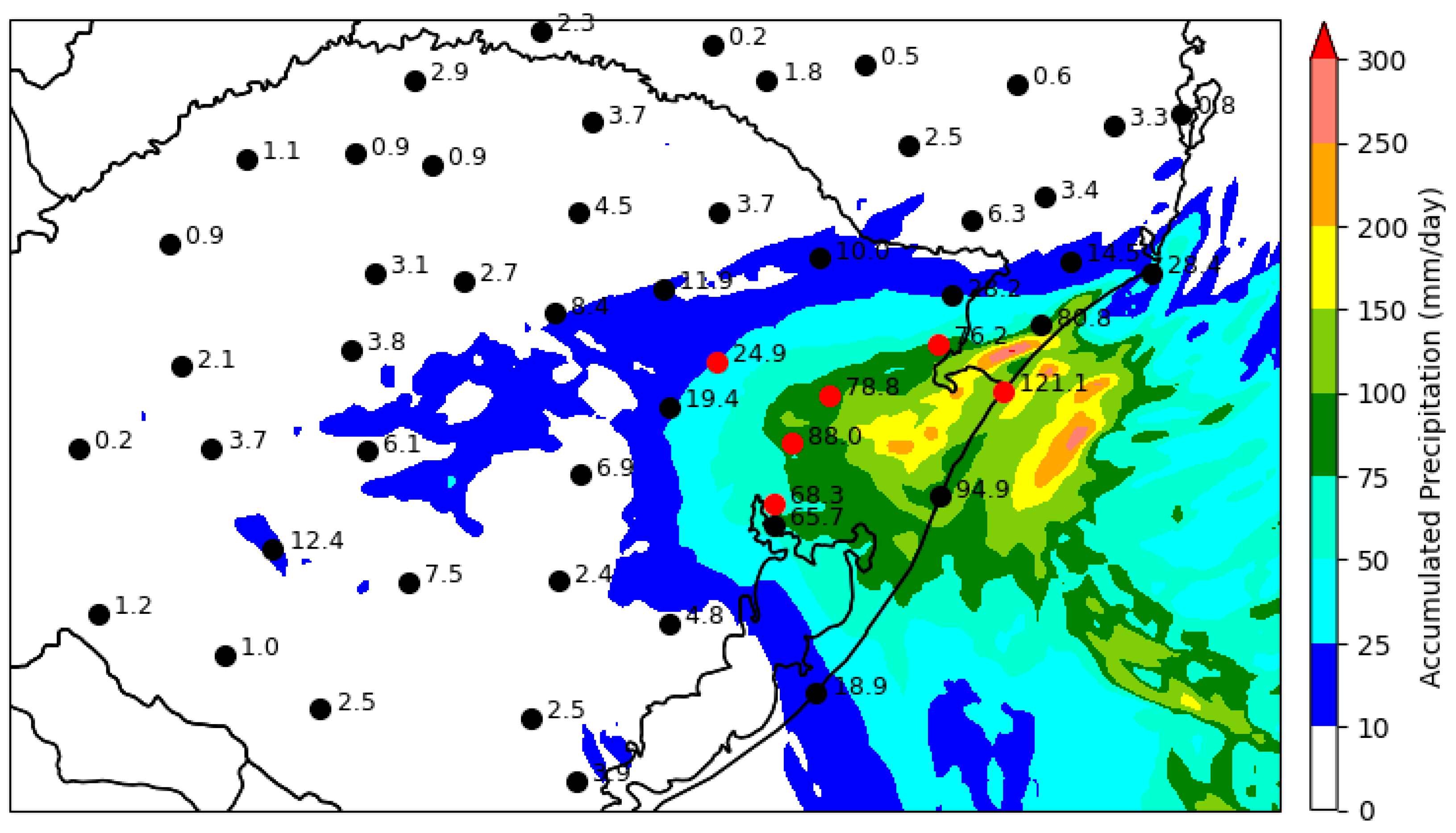

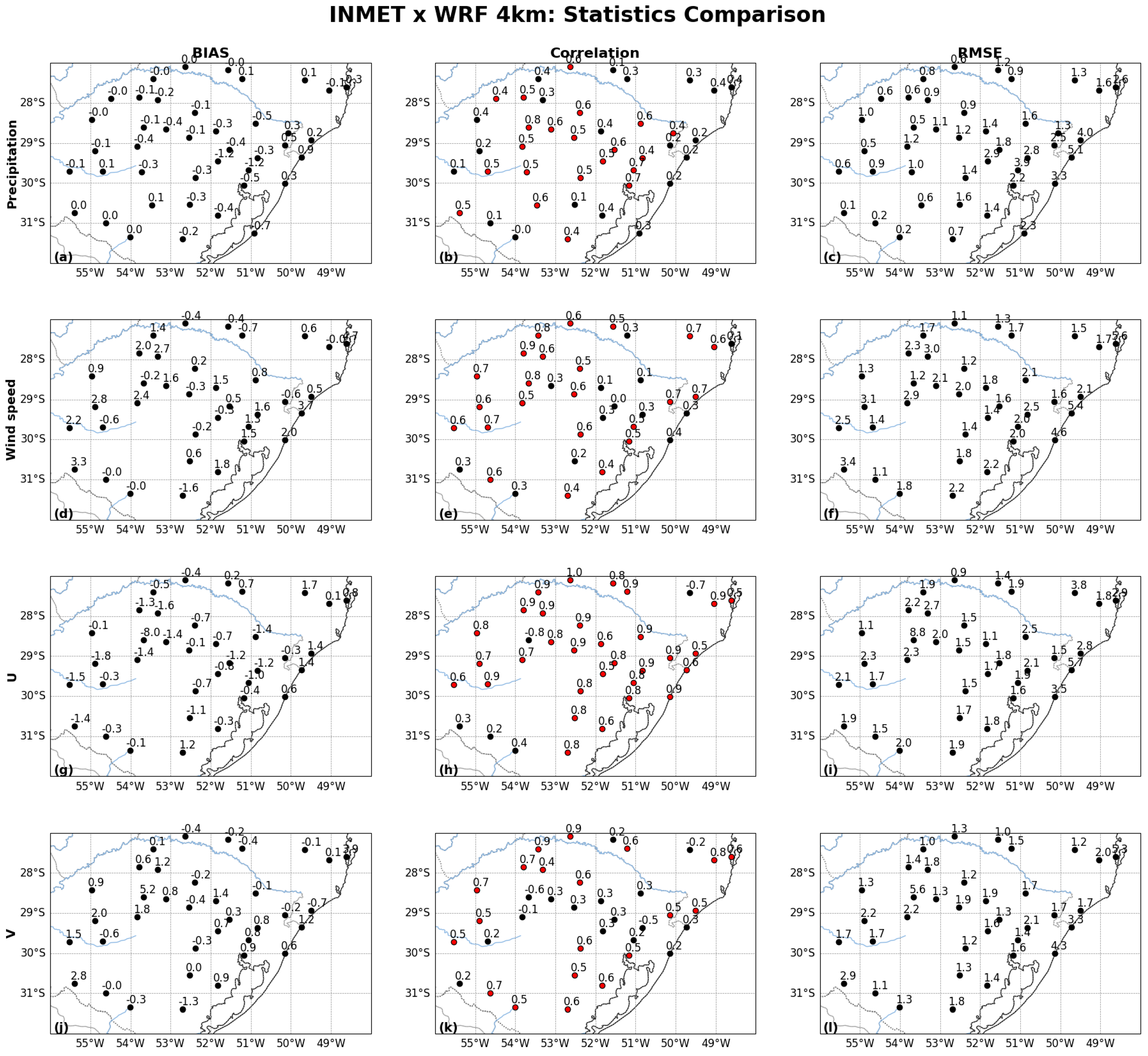
Disclaimer/Publisher’s Note: The statements, opinions and data contained in all publications are solely those of the individual author(s) and contributor(s) and not of MDPI and/or the editor(s). MDPI and/or the editor(s) disclaim responsibility for any injury to people or property resulting from any ideas, methods, instructions or products referred to in the content. |
© 2025 by the authors. Licensee MDPI, Basel, Switzerland. This article is an open access article distributed under the terms and conditions of the Creative Commons Attribution (CC BY) license (https://creativecommons.org/licenses/by/4.0/).
Share and Cite
Magalhães, M.H.d.O.A.; Reboita, M.S.; da Rocha, R.P.; Baldoni, T.C.; Gomes, G.D.; Mattos, E.V. Convection-Permitting Ability in Simulating an Extratropical Cyclone Case over Southeastern South America. Atmosphere 2025, 16, 675. https://doi.org/10.3390/atmos16060675
Magalhães MHdOA, Reboita MS, da Rocha RP, Baldoni TC, Gomes GD, Mattos EV. Convection-Permitting Ability in Simulating an Extratropical Cyclone Case over Southeastern South America. Atmosphere. 2025; 16(6):675. https://doi.org/10.3390/atmos16060675
Chicago/Turabian StyleMagalhães, Matheus Henrique de Oliveira Araújo, Michelle Simões Reboita, Rosmeri Porfírio da Rocha, Thales Chile Baldoni, Geraldo Deniro Gomes, and Enrique Vieira Mattos. 2025. "Convection-Permitting Ability in Simulating an Extratropical Cyclone Case over Southeastern South America" Atmosphere 16, no. 6: 675. https://doi.org/10.3390/atmos16060675
APA StyleMagalhães, M. H. d. O. A., Reboita, M. S., da Rocha, R. P., Baldoni, T. C., Gomes, G. D., & Mattos, E. V. (2025). Convection-Permitting Ability in Simulating an Extratropical Cyclone Case over Southeastern South America. Atmosphere, 16(6), 675. https://doi.org/10.3390/atmos16060675






